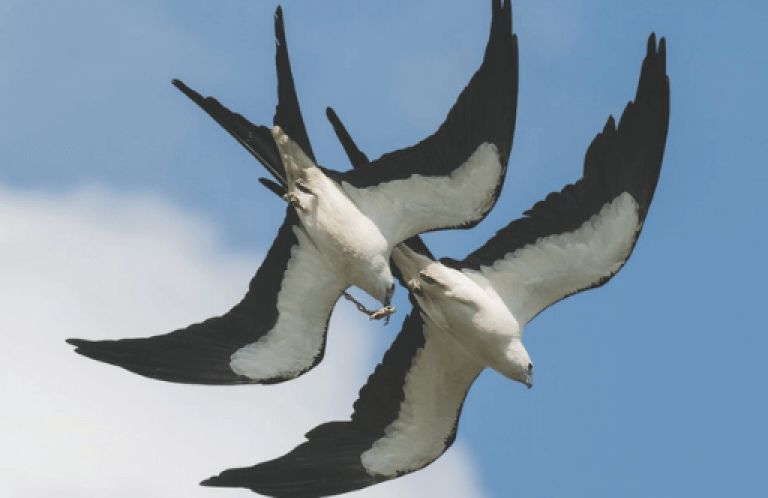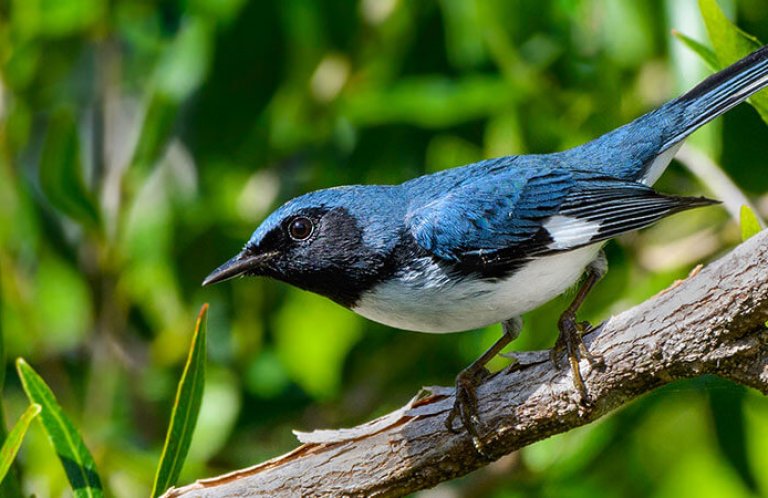Keeping Up with Swallow-tailed Kites
The Swallow-tailed Kite is instantly recognizable in the summertime skies of the Southeastern United States. Capable aerial acrobats, they cut a sleek and elegant figure as they glide through the air, the white of their bodies punctuated by the black edges along their wings and namesake forked tail. With a flick of its rudder-like tail, the kite can maneuver easily to change directions on a dime mid-flight without a wingbeat.
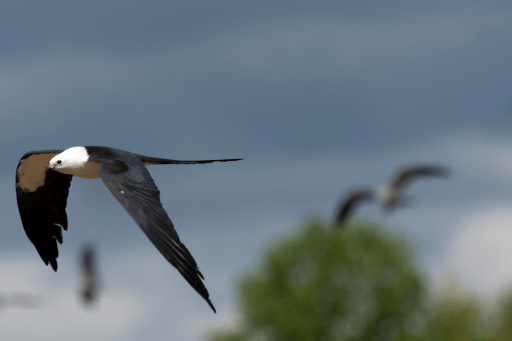
The Swallow-tailed Kite applies this same aptitude to long-distance migration, which takes the U.S. subspecies as far south as Brazil. (A second recognized subspecies is a year-round resident in Central and South America.) Once the breeding season has ended, kites take to the skies, sometimes migrating in groups of a thousand or more. These birds are rarely alone — their social nature is unique among most raptor species. However, new data on individual kites' movements can help to create a brighter future for the whole species.
This species was in decline for decades. Their breeding range shrank by the 1940s, likely resulting from clearing and draining bottomland forests, and illegal shooting and perhaps egg collecting placed more pressure on the species. By the mid-20th century, the sight of their silhouettes in flight was far less common. After decades of conservation work, the population of Swallow-tailed Kites in the U.S. has stabilized, thanks, in part, to conserving large expanses and the sustainable management of working forests.
The forest habitats kites use for roosting, nesting, and raising young overlap with working forests integral to the production of fiber and forest products. Knowing how kites are using working forests is a key to their conservation, and the flights of individual birds can offer invaluable insight into forest management.
Much about Swallow-tailed Kite migration is a mystery, but tracking technology is shedding light on the timing and routes of their movements, allowing researchers and conservationists to keep up with individual kites when they are on the wing. In 2019, American Bird Conservancy (ABC) and International Paper (IP) launched a bold partnership to integrate bird conservation into IP's substantial operations across the Southeastern U.S., and IP is supporting ABC's work with partners at Avian Research and Conservation Institute (ARCI) and Orleans Audubon Society to safely and carefully capture the kites. The birds are equipped with small GPS transmitters and released. Using the data from the transmitters, several Swallow-tailed Kites are helping researchers paint a picture of their travels that can guide forest management and conservation efforts.
“Swallow-tailed Kites tell us so much about sustainable forest landscapes,” said EJ Williams, ABC's Vice President for the Southeast Region. “They indicate the presence of large trees, healthy riparian forests, and a diverse mosaic of conditions capable of providing the varied prey needed to raise their young, including large insects, snakes, frogs, and fledgling birds. They are also big, charismatic birds that make bird-friendly forest practices appealing and relatable to forest landowners. When a kite appears, it changes the conversation from what landowners want, to what they can do for these birds.”
A Long Way from the Altamaha River
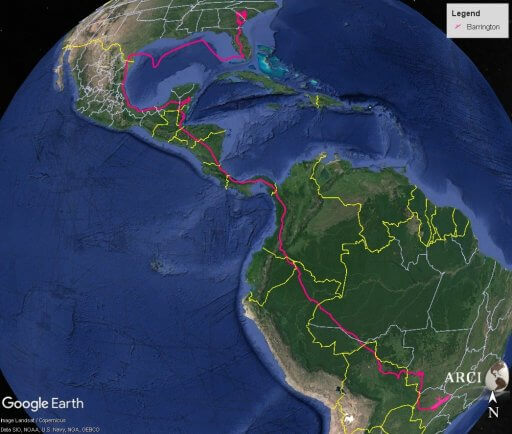
In July 2023, two male Swallow-tailed Kites captured by ARCI set out for Brazil, departing from separate points along Georgia's winding Altamaha River. Though they began their journeys within a few miles of each other and both aimed to reach central Brazil, their respective travels took them on wildly different routes!
The Snuffbox Canal male — named for the area where he was banded and fitted with a transmitter— set his sights south from the Altamaha. He spent a month in Florida preparing for the flight across the Gulf of Mexico and beyond at a pre-migration roost, a site where hundreds of kites gather ahead of their journeys. They eat with abandon at roosts throughout the Southeastern U.S., building up the fat reserves necessary for the exhausting 5,000-mile trip. On August 14, Snuffbox Canal was on his way. After a one-night stay in Cuba, he flew west, eventually landing in Cancun, Mexico. After seven days in Quintana Roo, Mexico, he was again on the move, reaching his non-breeding grounds near Barreiro do Campo, Mato Grosso, on the western edge of central Brazil.
Elsewhere along the Altamaha, the Barrington male's journey began alongside some 600 other kites at the state's largest known Swallow-tailed Kite roost, discovered by Georgia Department of Natural Resources biologists based on Barrington's GPS locations. What might have been a straight shot over the Gulf of Mexico on August 20 became a westward flight thanks to strong tailwinds. After 48 hours over the water, he landed on Padre Island in Texas. Perhaps wary of another two-day stint on the wing, he continued over land, rounding the Gulf of Mexico before going south to Bolivia. He stayed for 25 days in Aldeia Zamaicara, Mato Grosso, Brazil in October, only a couple hundred miles away from the Snuffbox Canal male, before settling in for the winter on November 12 in Ribas do Rio Pardo, Mato Grosso do Sul.
Going Slow and Steady in the Skies
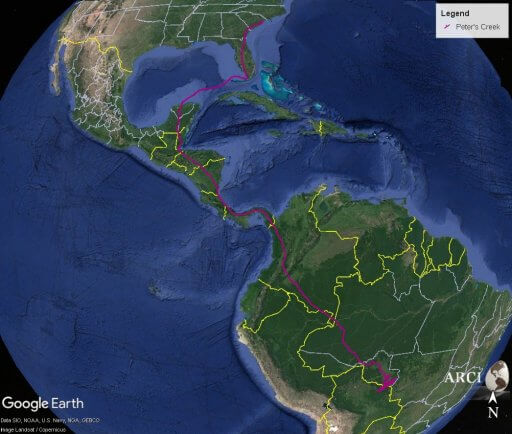
A third male — this one from Peter's Creek, captured near Georgetown, South Carolina in June 2021 — also spent a night along the Altamaha River in Georgia and lingered in Florida before striking out across the Gulf of Mexico on August 13. He followed a route similar to the Snuffbox Canal male's, but his pace was more “scenic route” than speedy. He made his way slowly through Mexico, then Belize. He finally landed on his non-breeding grounds near São Felipe D'Oeste, Rondônia, Brazil on September 28, where he stayed for one and a half months before flying southwest.
After departing the Waccamaw River in Georgia and swinging by Florida for a brief stay, another male kite known as Simmon's Creek, moved along to Cuba for one night before settling in the Yucatan for 12 days. He reached his final stop, Mato Grosso, Brazi, in mid-November. Researchers aren't sure what accounts for differences in travel patterns and the length of time kites stay at stopover sites. There is even great variation in the travel patterns and timings of individual birds from one year to the next. These are questions that beg answers, and those answers may come from the continued tracking of individual kites.
Missed Connections and Spotty Signals
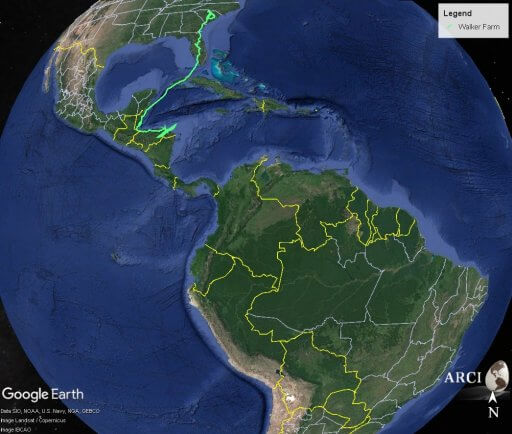
Occasionally, a bird will “go silent.” Their transmitter fails, or they fly outside the range of the cell towers vital for sending back flight data to the researchers. This is likely the case with two females tracked in the fall of 2023. The Big Branch female sent spotty GPS location data all spring and summer close to her previous nesting site in South Carolina. Data from her transmitter was steadier and more consistent in late August as she made her way through Nicaragua, Costa Rica, and Panama. On September 2, her transmitter went silent for nearly three months. Presumed alive but with a failing transmitter, the Big Branch female last connected to cell networks in late November in Brazil.
Before beginning migration the Walker Farm female flew along the path of the Santee River through South Carolina into North Carolina. Then, on August 11, she reversed course to Florida for four nights. After a quick jaunt from Immokalee, across the Ten Thousand Islands National Wildlife Refuge, and over the Gulf of Mexico, the Walker Farm female found herself in Guanahacabibes Peninsula at the western tip of Cuba. She paused for two days before she once again took to the skies southwest over Belize. She arrived in northern Honduras on August 29, and since then has gone silent, having flown beyond the reach of cell towers.
Coming Full-Circle on Kite Migration
Though each Swallow-tailed Kite follows its own path, there is a universal need for quality habitat for species at both ends of their migratory route and along it. In years past, the Swallow-tailed Kite nested in 21 states in the U.S. as far north as Minnesota. Today, they are known to nest in only seven states in the Southeast. Habitat loss has driven these declines, but a deeper understanding of their migratory patterns and habitat needs is slowly but steadily reversing the drop in population size. For nearly three decades, ARCI has maintained a database of kite sightings and a long-term monitoring program. These invaluable data offer a glimpse into the worlds and lives of individual Swallow-tailed Kites, but the whole population of these incredible birds benefits from those data.
The Swallow-tailed Kite is just one of many species that can thrive in working forests. Learn more about managing land for the benefit of birds and become a member of ABC. The support of ABC's members helps make projects like this possible.






































